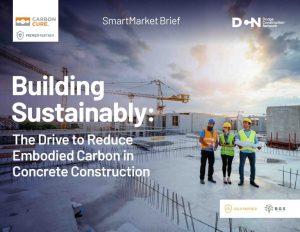Dodge-CarbonCure report confirms industry-wide carbon reduction priorities
New Dodge Construction research reveals how building interests are actively seeking to reduce the carbon footprint of concrete construction. Data shows that 81 percent of structural engineers and 69 percent of contractors working with concrete are tracking the embodied carbon on their projects, and about one third taking action to address the metric.
Published in partnership with CarbonCure Technologies with support from Bio Graphene Solutions, “The Building Sustainably: The Drive to Reduce Embodied Carbon in Concrete Construction” SmartMarket Brief report finds:
- Building owners are increasingly seeking the reduction of embodied carbon emissions generated during construction and materials production;
- Engineers and contractors are very familiar with the tools needed to track embodied carbon; and,
- Advancements in green concrete exist to support these goals, their adoption beginning to penetrate the industry.

The report is posted at www.construction.com
Building owner preferences are among the most important drivers of change in the construction industry, Dodge Construction researchers note, with 94 percent of engineers and contractors reporting that clients are requesting reductions of embodied carbon on their projects. The rise in environmental, social and governance (ESG) disclosures on financial ratings have been influential in this development. More than half of the engineers and contractors Dodge Construction surveyed report work for owners with ESG commitments. Nearly three quarters of respondents have observed an increase in the number of owners with such commitments in just the past year.
“In all the research we conduct, owner engagement is incredibly important to bring the rest of the industry onboard,” says Dodge Construction Industry Insights Research Director Donna Laquidara-Carr. “Their commitment to reducing embodied carbon is perhaps the most important factor in helping the industry achieve that goal, and we expect those impacts to continue to grow.”
Owner engagement is met by increasing sophistication in the use of the tools needed to address embodied carbon, environmental product declarations among them. “Building Sustainably” authors show that nearly all (98 percent) of engineers and contractors use EPDs on some of their projects, and 55 percent on all projects, when declarations are available. Broad engagement with EPDs is surging among survey respondents: 68 percent of those using EPDs note an increase in declaration submissions in just in the last year. Driving this trend, 63 percent of engineers and contractors report that most clients ask for EPDs on their projects.
In addition to EPDs, “Building Sustainably” survey data also shows that life cycle assessments (LCA) of projects, which include carbon measurements, are deployed by 78 percent of engineers and contractors on at least some of their projects. Meanwhile, the use of performance-based specifications, which enables the selection of concrete mixes or products based on their carbon content, is on the rise, with 51 percent of engineers and contractors expecting them to be employed on more projects in the next three years.
“This vital new research confirms what we’ve seen developing: Unprecedented demand for low embodied carbon concrete products, and for broadly available, robust LCAs,” observes CarbonCure Technologies Chair and CEO Robert Niven. “This increasing demand across the private and public sectors is accelerating the transformation of concrete into a global climate solution.”